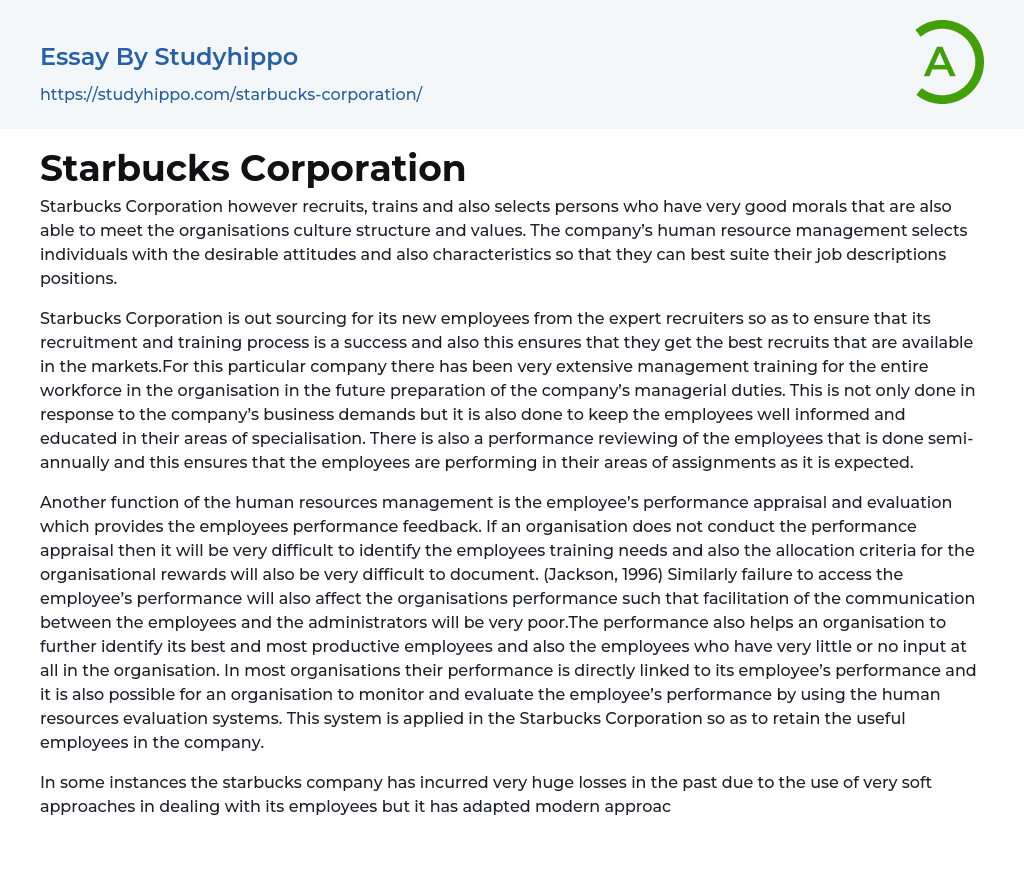Starbucks Corporation, however, recruits and trains individuals who possess strong moral values that align with the company's culture, structure, and values. The human resource management team of Starbucks carefully selects candidates who have the desired attitudes and characteristics, ensuring they are an ideal fit for their job descriptions and positions.
The Starbucks Corporation outsources recruitment to expert recruiters to ensure successful hiring and training. This allows them to secure the best candidates available in the market. Extensive management training is provided to all employees, preparing them for future managerial responsibilities and keeping them well-informed in their respective fields. Employees undergo semi-annual performance reviews to assess their performance in assigned tasks. Performance appraisals and evaluations are conducted to provide feedback and identify training needs. These evaluations also aid in documenting criteria for organizational rewards allocation. Without performance appraisa
...ls, it would be challenging to identify training needs and establish allocation criteria for rewards.(Jackson, 1996) Likewise, if access to an employee's performance is lacking, it will impact the organization's performance negatively. This will result in inadequate facilitation of communication between employees and administrators. Additionally, performance evaluation aids in identifying the organization's top and most efficient workers, as well as those contributing minimally or not at all.
The Starbucks Corporation utilizes human resources evaluation systems to monitor and evaluate employee performance. This system helps the company identify and retain valuable employees. In the past, Starbucks incurred significant losses due to lenient approaches in managing employees. However, the company now employs modern approaches, particularly with regards to unproductive employees referred to as "joy riders." These employees are considered a liability due to their high cost benefit ratio (Lynch, 1994). Improvements in individua
employee performance directly contribute to overall organizational improvement. Furthermore, Starbucks implements a tight control strategy, closely monitoring employees' daily activities and ensuring they adhere to company schedules and pace.The use of performance and evaluation assessment in human resource management allows employees to conduct personal self-assessment and promotes communication among them, motivating them to outperform each other. IBM and other companies have also adopted strategic human resource management strategies, resulting in significant improvements in organizational productivity.
The company regularly evaluates its employees to maintain high standards. It also rewards and motivates them to gain a competitive advantage. Retaining the best staff members is a key goal of human resource management. Starbucks invests time and resources in training employees to excel in their roles. Losing such employees would greatly impact the company's performance. To ensure employee retention, Starbucks offers financial and service rewards such as extended annual leaves and company paid vacations. (Source: Mark, 2001; Cosh, 1998; Jackson, 1996)
The company seeks cost-effective and convenient ways to motivate and engage employees, to enhance productivity and profitability. Human resource management plays a major role in industrial relations and organizational performance. It also manages relationships with trade unions and other professional organizations. All organizational relationships are handled by human resource management departments. Industrial relations directly impact international businesses, including tax rates, investment opportunities, and import duties standardizations. For Starbucks, policy factors, market constraints, and industrial actions significantly affect the company's performance.
If the workers decide to go on strike in the Starbucks company, the company will suffer significant losses in meeting consumer demands. To protect its public image and maintain production levels, the company ensures that it meets the basic needs
of consumers and follows a protocol to address employee issues privately. Some negative changes in the organization, such as transfers and unprofessional interpretations of company policies, can be detrimental to employees. Starbucks' human resource management is directly connected to the company's business goals and strongly reinforces its values and culture. The integrated HR system plays a crucial role in shaping the company's success, which is not solely based on conventional thinking or workforce trends (Baldwin & Chandler, 1994).
Reference:
Baldwin, J & Chandler, W. (1994): Strategies for Success, A Profile of Growing Small and Medium-sized Enterprises in Canada.
- Statistics Canada, Ottawa, Cambridge Small Business Research Centre (1992): The State of British Enterprises, Growth, Innovation and Competitive Advantage in Business Firms.
- University of Cambridge, Cambridge Cosh, A. (1998): Investing in Training and Businesses Growth and Survival, an Empirical Analysis for the UK 1987-97, HMSO, London, Lynch, L.(1994): Training and the Private Sector, International Comparisons, the University of Chicago Press, Chicago, IL Jackson, S. (1996): Human Resource Management: Positioning for the 21st Century, 6th ed. ,
- West Publishing, St Paul, MN, Mark, D. (2001): Human Resource Management and organisational performance; 3rd Edition of the Institute of Management, Washington, U. S Maundy, L. (2001): An Introduction to Human to Human Resource Management: Theory And Practice: Macmillan, Pal grave Harwood, K.(1996): Business as Ethical and Business as Usual, Belmont, CA:
- Performance essays
- Human Resources essays
- Recruitment essays
- Code of Ethics essays
- Organizational Behavior essays
- Dress Code essays
- Safety essays
- Conflict essays
- Qualities essays
- American Dream essays
- Barriers To Entry essays
- Capitalism essays
- Central Bank essays
- Compensation essays
- Consumerism essays
- Economic Development essays
- Economic Growth essays
- Economic Inequality essays
- Economic System essays
- Economy essays
- Employment essays
- Export essays
- Finance essays
- Free Trade essays
- Gross Domestic Product essays
- Human Development essays
- Income Inequality essays
- Industry essays
- Inflation essays
- International Business essays
- International Trade essays
- Macroeconomics essays
- Materialism essays
- Max Weber essays
- Microeconomics essays
- Minimum Wage essays
- Monetary Policy essays
- Monopoly essays
- Pricing essays
- Profit essays
- Recession essays
- resources essays
- Taxation essays
- Trade essays
- Unemployment essays
- Warehouse essays
- World economy essays
- Accounting essays
- Andrew Carnegie essays
- Automation essays




